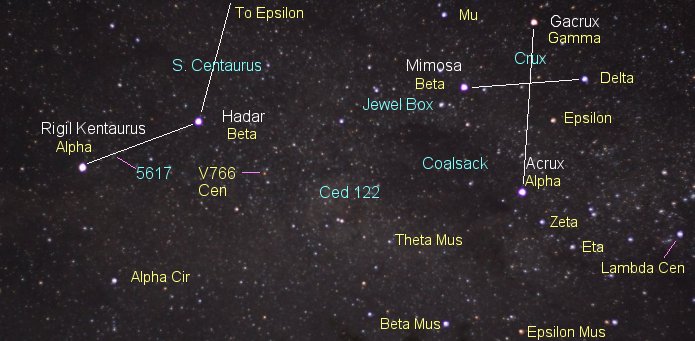CRUX AND SOUTHERN CENTAURUS
 Crux, the four-star Southern Cross, toward the upper right, lies
southwest of Centaurus, and precedes the two bright stars of the
Centaur across the southern sky. The smallest constellation in the sky, it
just beats Equuleus (the smallest ancient
constellation) for the
record. Rigel Kentaurus, Alpha Centauri,
the closest star to the Earth, lies at center left. Beta Centauri, Hadar,
falls between Alpha and the Cross. Epsilon Centauri, off the picture toward upper left,
links this photo to one of northern
Centaurus. The stars near the far right edge also belong
to Centaurus. Acrux, Crux's brightest star,
is at the bottom (the southern end) of the Cross, Mimosa (Beta
Crucis) is on the left side, Gacrux (Gamma Crucis) is on top, and
Delta Crucis is on the right. Mu Cru is the brighter star up and a bit to to the left
of Mimosa, while Epsilon is tucked into the lower right
quadrant of the Cross between Delta and Acrux. The two bright stars down and
to the right of Acrux are Zeta and Eta Cru.
Alpha Circini (of Circinus)
lies at lower left.
Crux, the four-star Southern Cross, toward the upper right, lies
southwest of Centaurus, and precedes the two bright stars of the
Centaur across the southern sky. The smallest constellation in the sky, it
just beats Equuleus (the smallest ancient
constellation) for the
record. Rigel Kentaurus, Alpha Centauri,
the closest star to the Earth, lies at center left. Beta Centauri, Hadar,
falls between Alpha and the Cross. Epsilon Centauri, off the picture toward upper left,
links this photo to one of northern
Centaurus. The stars near the far right edge also belong
to Centaurus. Acrux, Crux's brightest star,
is at the bottom (the southern end) of the Cross, Mimosa (Beta
Crucis) is on the left side, Gacrux (Gamma Crucis) is on top, and
Delta Crucis is on the right. Mu Cru is the brighter star up and a bit to to the left
of Mimosa, while Epsilon is tucked into the lower right
quadrant of the Cross between Delta and Acrux. The two bright stars down and
to the right of Acrux are Zeta and Eta Cru.
Alpha Circini (of Circinus)
lies at lower left.
Crux and southern Centaurus fall within a brilliant, and the most southern, portion of the
Milky Way. The picture features the famed "Coalsack," a large complex of
dark interstellar molecule-rich dust clouds
(in which stars are forming that lies below Mimosa. Just below center
is a large reddish cloud of interstellar hydrogen called Ced 122
that is illuminated by nearby and embedded stars. The compact
open cluster Kappa Crucis (the "Jewel Box") looks like a star down and to the left of Mimosa.
A fainter cluster, NGC 5299, is about a quarter of the way between Alpha and Beta Cen. The deep red star
just to the left of center is V 766 Cen, a luminous supergiant (possible hypergiant) whose light is
heavily absorbed and reddened by interstellar dust.
 Crux, the four-star Southern Cross, toward the upper right, lies
southwest of Centaurus, and precedes the two bright stars of the
Centaur across the southern sky. The smallest constellation in the sky, it
just beats Equuleus (the smallest ancient
constellation) for the
record. Rigel Kentaurus, Alpha Centauri,
the closest star to the Earth, lies at center left. Beta Centauri, Hadar,
falls between Alpha and the Cross. Epsilon Centauri, off the picture toward upper left,
links this photo to one of northern
Centaurus. The stars near the far right edge also belong
to Centaurus. Acrux, Crux's brightest star,
is at the bottom (the southern end) of the Cross, Mimosa (Beta
Crucis) is on the left side, Gacrux (Gamma Crucis) is on top, and
Delta Crucis is on the right. Mu Cru is the brighter star up and a bit to to the left
of Mimosa, while Epsilon is tucked into the lower right
quadrant of the Cross between Delta and Acrux. The two bright stars down and
to the right of Acrux are Zeta and Eta Cru.
Alpha Circini (of Circinus)
lies at lower left.
Crux, the four-star Southern Cross, toward the upper right, lies
southwest of Centaurus, and precedes the two bright stars of the
Centaur across the southern sky. The smallest constellation in the sky, it
just beats Equuleus (the smallest ancient
constellation) for the
record. Rigel Kentaurus, Alpha Centauri,
the closest star to the Earth, lies at center left. Beta Centauri, Hadar,
falls between Alpha and the Cross. Epsilon Centauri, off the picture toward upper left,
links this photo to one of northern
Centaurus. The stars near the far right edge also belong
to Centaurus. Acrux, Crux's brightest star,
is at the bottom (the southern end) of the Cross, Mimosa (Beta
Crucis) is on the left side, Gacrux (Gamma Crucis) is on top, and
Delta Crucis is on the right. Mu Cru is the brighter star up and a bit to to the left
of Mimosa, while Epsilon is tucked into the lower right
quadrant of the Cross between Delta and Acrux. The two bright stars down and
to the right of Acrux are Zeta and Eta Cru.
Alpha Circini (of Circinus)
lies at lower left.